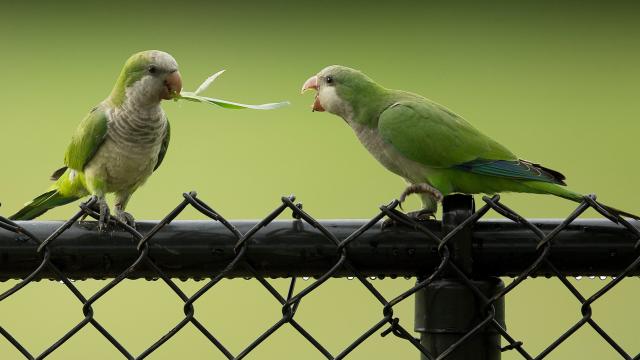Visitors to Chicago’s Hyde Park or New York’s Green-Wood Cemetery may be surprised to hear the raucous squawks of lime-green monk parakeets. These birds, descendants of escaped pets, have managed to create thriving colonies in these cities despite the annual cold weather. It turns out they’re far from unusual — escaped pet parrots have established breeding populations in nearly half of U.S. states, according to a new analysis.
The United States was home to just two native parrot species, the Carolina parakeet (now extinct) and the thick-billed parrot (now only found in Mexico). But that doesn’t mean Americans don’t have plenty of opportunities to see free-flying parrots. As new research describes, there are 56 parrot species living in the wild across 23 U.S. states. Of those, 25 species have formed breeding colonies.
The Migratory Bird Treaty Act makes it illegal to own any bird (or any part of a bird) from a list of hundreds of native species. Instead, the pet trade, both legally and illegally, imports exotic bird species like parrots—and inevitably, some of these birds escape and occasionally breed. All of the parrots documented in this research, with two possible exceptions, descended from escaped pets.
A team of scientists, led by Cornell graduate student Jennifer Uehling, reviewed parrot observations from 15 years of community science observations—specifically, the annual Christmas Bird Count and Cornell University’s ubiquitous eBird database. Birders log their sightings along with comments, and reviewers confirm any rarities with more details, further observations, and photos. The researchers determined that a bird population was “established” if birdwatchers had observed the species 25 or more times (a purposely high but relatively arbitrary number) and if records included observations of breeding.
The data review showed that 56 species had been observed 118,744 times at 19,812 unique locations, according to the paper published in the Journal of Ornithology. The monk parakeet accounted for more than a third of the observations, while red-crowned Amazons and Nanday parakeets accounted for 13.3 per cent and 11.9 per cent of the sightings, respectively. California, Florida, and Texas accounted for most of the records.
This is community science data, so it’s worth looking sceptically at some of the observations. But still, that’s a lot of parrots.
How do parrots survive in a foreign habitat? The researchers explain that monk parakeets can build their nests in natural or human-made structures, adjust their diets to survive in the cold, and can establish new populations far away from where they were born. They’re particularly good at surviving in human-altered habitats.
The researchers note that density of humans and the minimum January temperature have the biggest impact on the diversity of naturalized parrots—which is why it shouldn’t be surprising that southern Texas, southern Florida, and southern California have the most parrots.
But should these colourful colonies be celebrated or removed, given that the birds are invasive? Eradication efforts are occasionally met with resistance from bird lovers, and proposed laws in some states, including New York and New Jersey, would further protect monk parakeets, according to the new paper. The red-crowned Amazon is red-listed by the International Union for Conservation of Nature in its native range, and might receive similar protections in the United States.
For now, the answer is that scientists need to do more science, and establish what effects, if any, parrots have on native species (for now, there’s no evidence either way, according to the paper). But it’s clear that humans alter their environments in ways you might not expect, such that animals from around the world have now established populations far from their home ranges.
